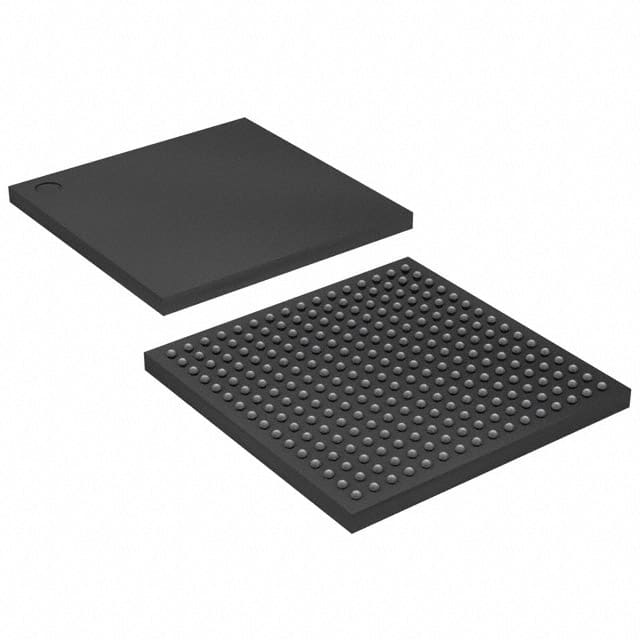XC2C384-10FTG256I
Product Overview
Category
XC2C384-10FTG256I belongs to the category of programmable logic devices (PLDs).
Use
This product is primarily used for digital circuit design and implementation. It provides a flexible and customizable solution for various applications.
Characteristics
- Programmable: The XC2C384-10FTG256I can be programmed to perform specific functions, allowing for versatile use.
- High-density: This PLD offers a high number of logic elements, enabling complex designs.
- Fast operation: With a maximum operating frequency of 10 MHz, it ensures efficient performance.
- Low power consumption: The XC2C384-10FTG256I is designed to minimize power usage, making it suitable for battery-powered devices.
Package
The XC2C384-10FTG256I comes in a FTG256 package, which refers to a Fine-Pitch Thin Grid Array with 256 pins.
Essence
The essence of this product lies in its ability to provide reconfigurable logic functionality, allowing users to implement custom digital circuits without the need for dedicated hardware.
Packaging/Quantity
The XC2C384-10FTG256I is typically packaged individually and is available in various quantities depending on the manufacturer's specifications.
Specifications
- Logic Elements: 384
- Maximum Operating Frequency: 10 MHz
- I/O Pins: 256
- Supply Voltage: 3.3V
- Operating Temperature Range: -40°C to 85°C
- Configuration Memory: Flash-based
Detailed Pin Configuration
The XC2C384-10FTG256I has a total of 256 I/O pins, each serving a specific purpose in the circuit design. For a detailed pin configuration diagram, please refer to the datasheet provided by the manufacturer.
Functional Features
- Reconfigurable Logic: The XC2C384-10FTG256I allows users to modify the logic functions according to their requirements, providing flexibility in circuit design.
- In-system Programming: This PLD supports in-system programming, enabling updates and modifications without removing it from the target system.
- JTAG Interface: It features a Joint Test Action Group (JTAG) interface for debugging and testing purposes.
Advantages and Disadvantages
Advantages
- Flexibility: The reconfigurable nature of the XC2C384-10FTG256I allows for quick prototyping and design changes.
- Cost-effective: By eliminating the need for dedicated hardware, this PLD reduces overall costs.
- High-density: With 384 logic elements, it can handle complex designs efficiently.
Disadvantages
- Limited Performance: Compared to application-specific integrated circuits (ASICs), PLDs like the XC2C384-10FTG256I may have lower performance capabilities.
- Learning Curve: Utilizing the full potential of this PLD requires knowledge of hardware description languages and digital circuit design principles.
Working Principles
The XC2C384-10FTG256I operates based on the concept of field-programmable gate arrays (FPGAs). It consists of configurable logic blocks interconnected through programmable routing resources. These logic blocks can be programmed to perform specific functions by configuring the interconnections between them.
Detailed Application Field Plans
The XC2C384-10FTG256I finds applications in various fields, including but not limited to: - Embedded Systems: It can be used to implement custom logic in microcontroller-based systems. - Communication Systems: This PLD enables the design of custom communication protocols and interfaces. - Industrial Automation: It provides flexibility in designing control systems for industrial automation processes. - Signal Processing: The XC2C384-10FTG256I can be utilized for real-time signal processing applications.
Detailed and Complete Alternative Models
- XC2C384-7FTG256I: Similar to the XC2C384-10FTG256I, but with a maximum operating frequency of 7 MHz.
- XC2C384-12FTG256I: Similar to the XC2C384-10FTG256I, but with a maximum operating frequency of 12 MHz.
- XC2C384-15FTG256I: Similar to the XC2C384-10FTG256I, but with a maximum operating frequency of 15 MHz.
These alternative models offer different performance characteristics while maintaining similar functionality to the XC2C384-10FTG256I.
Word count: 511 words
10個與XC2C384-10FTG256I在技術方案中應用相關的常見問題與解答
Sure! Here are 10 common questions and answers related to the application of XC2C384-10FTG256I in technical solutions:
Q: What is XC2C384-10FTG256I? A: XC2C384-10FTG256I is a specific model of Field-Programmable Gate Array (FPGA) manufactured by Xilinx.
Q: What is an FPGA? A: FPGA stands for Field-Programmable Gate Array, which is a type of integrated circuit that can be programmed after manufacturing to perform specific functions.
Q: What are the key features of XC2C384-10FTG256I? A: Some key features of XC2C384-10FTG256I include 384 macrocells, 10ns maximum propagation delay, and a 256-pin Fine-Pitch Ball Grid Array (FBGA) package.
Q: What are the typical applications of XC2C384-10FTG256I? A: XC2C384-10FTG256I is commonly used in various technical solutions such as digital signal processing, embedded systems, telecommunications, and industrial automation.
Q: How can XC2C384-10FTG256I be programmed? A: XC2C384-10FTG256I can be programmed using Hardware Description Languages (HDLs) like VHDL or Verilog, which describe the desired functionality of the FPGA.
Q: Can XC2C384-10FTG256I be reprogrammed multiple times? A: Yes, XC2C384-10FTG256I is a reprogrammable FPGA, allowing it to be reconfigured multiple times to implement different designs or functionalities.
Q: What tools are required to program XC2C384-10FTG256I? A: To program XC2C384-10FTG256I, you would typically need a development board or programmer compatible with Xilinx FPGAs, along with appropriate software like Xilinx ISE or Vivado.
Q: What is the power supply requirement for XC2C384-10FTG256I? A: XC2C384-10FTG256I requires a 3.3V power supply for proper operation.
Q: Can XC2C384-10FTG256I interface with other components or devices? A: Yes, XC2C384-10FTG256I can interface with various components and devices through its I/O pins, allowing it to communicate with external peripherals or integrate into larger systems.
Q: Are there any limitations or considerations when using XC2C384-10FTG256I? A: Some considerations include the limited number of macrocells, the maximum propagation delay, and the need for proper cooling due to power consumption. Additionally, understanding FPGA design principles and programming languages is essential for successful implementation.
Please note that the answers provided here are general and may vary depending on specific requirements and use cases.


